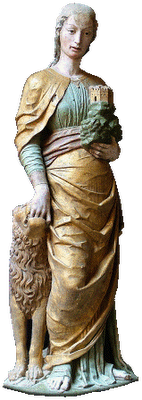 Sull’ultimo numero di “Aperture” John Berger presenta la ristampa di “Nicaragua” il libro di Susan Meiselas (Magnum Photos) e fa un paragone abbastanza ardito:
Sull’ultimo numero di “Aperture” John Berger presenta la ristampa di “Nicaragua” il libro di Susan Meiselas (Magnum Photos) e fa un paragone abbastanza ardito:
“When I recently watched Pictures from a Revolution, the film about her returning to Nicaragua ten years after she took the photographs, I kept asking myself who Meiselas, with all her reticence and discretion, reminded me of?
I couldn’t find the answer, and anyway, like each one of us, she’s unique. The next morning it came to me. She reminded me not of another person, but of a sculpture: the only existing sculpture by the Italian Renaissance painter Andrea Mantegna. I looked again at the reproduction I have of it. Yes. It is not a question of a look-alike (although their physical stances are similar) but of that mysterious attitude which is a presence. A presence is a source of energy offered to others. Yes. The sculpure figure has her right hand in the mouth of a lion that does not bite it, and in her left she holds a tower on a rock – a place – against her heart. She’s defending both a faith and a place. Among the great artists of the Renaissance, Mantegna was the one perhaps most affected by a sense of History and the lesson of Antiquity. He wanted his figures to offer examples of human behavior, which would inspire the living in their wager that it was still possible – despite all the shit – to make life more human.
The sculpure figure has her right hand in the mouth of a lion that does not bite it, and in her left she holds a tower on a rock – a place – against her heart. She’s defending both a faith and a place. Among the great artists of the Renaissance, Mantegna was the one perhaps most affected by a sense of History and the lesson of Antiquity. He wanted his figures to offer examples of human behavior, which would inspire the living in their wager that it was still possible – despite all the shit – to make life more human.
Her hand in the mouth of a lion, the other holding a place against her heart, upright, with an unflichting gaze, a camera slung across her shoulders, an example given and a wager made – all this is why Susan, although not a saint, made me think of Mantegna’s sculpture. And now vice versa”.
Ps: è un caso che la statua fosse al Louvre per la mostra di Mantegna?
UPDATE – riceviamo e pubblichiamo
Bello il tuo post,
interessante, preciserei solo che la statua non è di Mantegna ma di Pietro Lombardo, e ispirata a Mantegna, che per la stessa Cattedrale di Irsina esegue un dipinto analogo ora al Museo napoletano di Capodimonte (1454)
Ciao
d.d.
